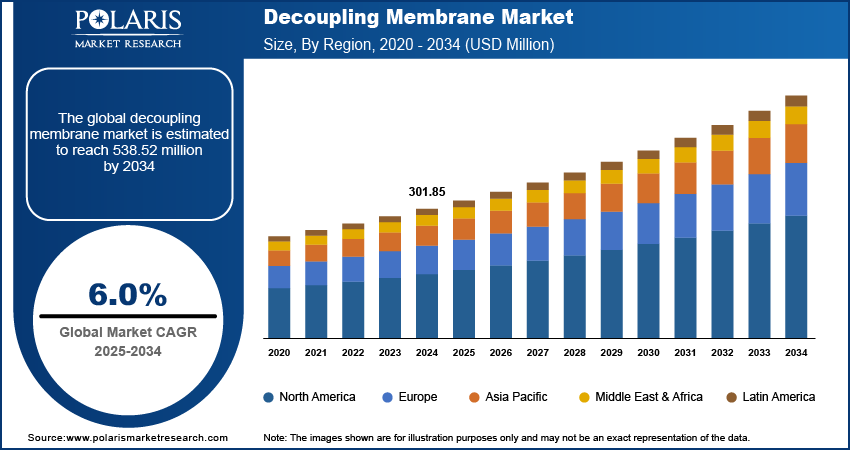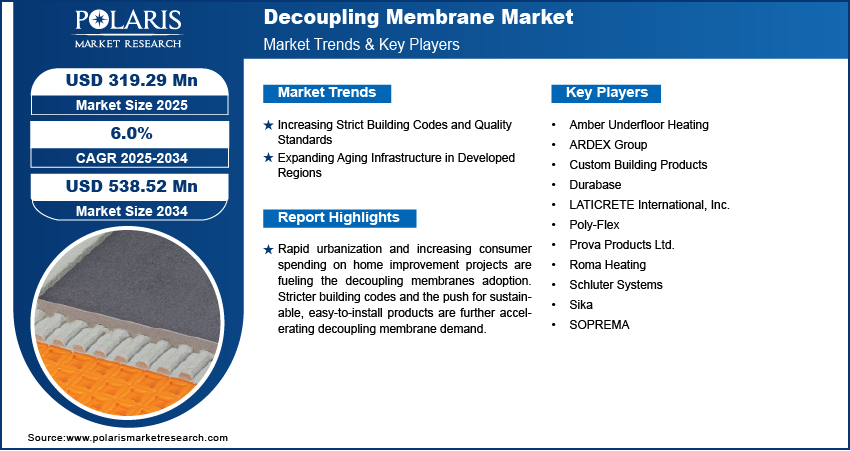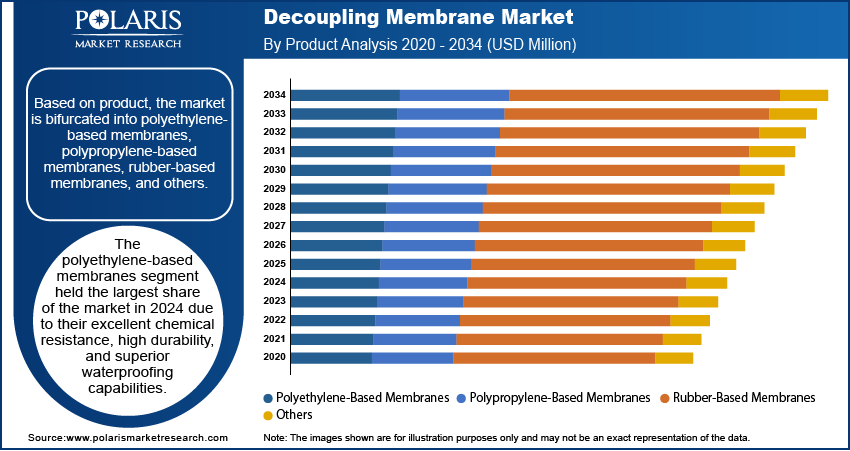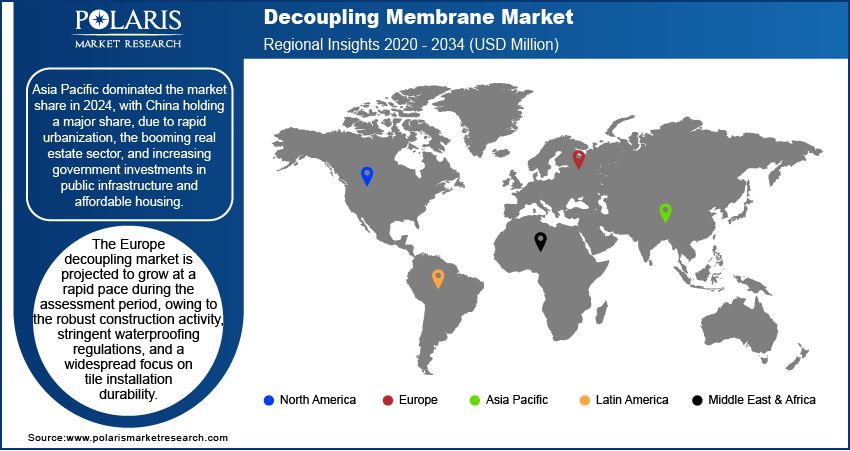
Decoupling Membrane Market Size, Share, Trends, & Industry Analysis Report
: By Product, By End Use (Residential, Commercial, and Industrial), and By Region – Market Forecast, 2025–2034
- Published Date:Jun-2025
- Pages: 129
- Format: PDF
- Report ID: PM5736
- Base Year: 2024
- Historical Data: 2020-2023
Market Overview
The global decoupling membrane market size was valued at USD 301.85 million in 2024, growing at a CAGR of 6.0 % during 2025–2034. Rapid urbanization and increasing consumer spending on home improvement projects are fueling the adoption of decoupling membranes. Stricter building codes and the push for sustainable, easy-to-install products are further accelerating decoupling membrane demand.
A decoupling membrane is a flexible, engineered layer installed between the substrate and the tiles in flooring or wall applications. Its primary function is to isolate the tiled surface from any movement, stress, or cracks that may occur in the underlying substrate. The decoupling membrane acts as a buffer or stress-relief layer. Many decoupling membranes are designed with waterproofing properties, making them highly suitable for wet areas such as bathrooms, wet rooms, and kitchens. Decoupling membranes can enhance the durability and longevity of tiled installations, reduce maintenance costs, and even offer added benefits such as improved thermal efficiency and sound dampening, which is valuable in multi-story buildings.
The growing urbanization globally is driving the decoupling membrane market growth. Urbanization leads to expansion in construction activities, especially in high-rise buildings, commercial complexes, and public infrastructure. These structures require durable and efficient solutions to manage substrate movement, prevent tile cracking, and ensure long-lasting flooring installations. Decoupling membranes provide a reliable method to address these challenges, making them a preferred choice among builders and contractors in urban environments. Additionally, urban areas usually witness higher foot traffic, especially in commercial buildings such as malls, airports, and hospitals. These buildings demand robust flooring that can handle dynamic loads without failing. Decoupling membranes enhance the durability of flooring in such high-traffic buildings by mitigating stress transmission from the substrate. For instance, World Economic Forum in its 2022 report stated that the share of the world’s population living in cities is expected to rise to 80% by 2050, from 55% in 2022. Therefore, as urban populations continue to rise globally, the need for resilient and long-lasting construction materials such as decoupling membranes is projected to grow during the forecast period.

To Understand More About this Research: Request a Free Sample Report
The decoupling membrane demand is driven by rising disposable income globally. Homeowners with higher disposable income are more likely to undertake renovation projects, especially in kitchens, bathrooms, and living areas where tile is commonly used. These renovation activities often include the use of advanced materials that deliver better results and long-term benefits. Builders and contractors recommend decoupling membranes in such projects to provide superior floor stability and waterproofing, which adds to the overall value of the property. Moreover, increased disposable income encourages the construction of high-end commercial spaces such as hotels, retail outlets, and office buildings. Developers of these properties allocate larger budgets for flooring that can withstand heavy use while maintaining their appearance. Decoupling membranes support this goal by minimizing substrate-related issues and extending the lifespan of floor finishes. According to data published by the Bureau of Economic Analysis, the disposable personal income in the US increased by 0.7% in April 2025 from March 2025. Thus, the demand for decoupling membranes is increasing with the rising disposable income globally.
Industry Dynamics
Expanding Aging Infrastructure in Developed Regions
Many buildings, transportation hubs, and public facilities constructed decades ago in regions such as North America and Europe now require structural upgrades and modernized interiors. These renovation efforts usually involve renovating floors and walls, where the decoupling membrane is used to protect new tile installations from cracking, lifting, or debonding due to movement or stress in the underlying substrate. Moreover, governments and municipalities in developed countries prioritize sustainable and resource-efficient construction practices when restoring older infrastructure. Decoupling membranes align with these goals by enabling the reuse of existing substrates and minimizing demolition waste. Therefore, aging infrastructure in developed regions boosts the need for renovation projects, creating the demand for decoupling membranes.
Increasing Strict Building Codes and Quality Standards
Regulatory bodies in many regions are enforcing strict standards related to structural integrity, moisture control, and flooring durability. These regulations aim to enhance safety, extend the lifespan of buildings, and reduce future maintenance costs. To comply with these requirements, construction professionals are turning to decoupling membranes, which provide proven performance in preventing tile damage, managing substrate movement, and improving overall tile installation quality. Additionally, stricter environmental and energy-efficient building standards often require construction materials that minimize waste, support sustainable practices, and ensure longevity. Decoupling membranes support these goals by reducing the need for frequent tile replacement, enabling installations over existing substrates, and lowering the risk of moisture-related damage. Hence, as building regulations evolve and become more stringent across regions, the demand for decoupling membranes is projected to rise during the forecast period.

Segmental Insights
By Product Analysis
Based on product, the market is segmented into polyethylene-based membranes, polypropylene-based membranes, rubber-based membranes, and others. The polyethylene-based membranes segment held the largest share in 2024 due to their excellent chemical resistance, high durability, and superior waterproofing capabilities. The flexibility and lightweight structure of this membrane allowed for easier installation, especially in environments exposed to high moisture, such as bathrooms, kitchens, and basements. Furthermore, polyethylene-based membranes demonstrated strong crack-bridging properties, which contributed to their dominance. The growing trend of large-format tiles and underfloor heating systems in Europe and North America further supported the dominance of this segment, as polyethylene materials performed effectively under thermal and mechanical stress.
The rubber-based membranes segment is expected to grow at a robust pace in the coming years, owing to the increasing awareness regarding sustainability and recyclability, as many rubber membranes are produced using post-consumer or post-industrial materials. Rubber-based alternatives also offer superior sound insulation and impact absorption, making them ideal for multi-story buildings and high-traffic commercial environments. Additionally, advancements in formulations have improved their resistance to UV radiation and temperature fluctuations, expanding their application in outdoor and balcony installations.
By End Use Analysis
Based on end use, the market is divided into residential, commercial, and industrial. The commercial segment is projected to grow at a rapid pace during the forecast period owing to the expansion of commercial infrastructure, including hotels, hospitals, office complexes, and retail centers. Builders and contractors increasingly prefer decoupling membranes as they offer superior load-bearing capacity, noise reduction, and crack isolation in high-traffic environments. Moreover, stringent building codes and green construction practices in several countries are elevating the importance of efficient waterproofing membranes and energy-saving materials in commercial settings, such as decoupling membranes.

Regional Analysis
By region, the market report provides insight into North America, Europe, Asia Pacific, Latin America, and the Middle East & Africa. Asia Pacific dominated the market share in 2024. China holds a major share in the region, due to rapid urbanization, the booming real estate sector, and increasing government investments in public infrastructure and affordable housing. The country’s growing emphasis on quality construction materials, coupled with rising consumer awareness about preventing substrate cracks and managing thermal expansion, drove demand for decoupling membranes. Furthermore, the integration of modern building techniques, coupled with China’s large-scale smart city initiatives, supported the continuous adoption of decoupling membranes in both residential and commercial projects. For instance, China’s Smart Cities Development report stated that China has nearly 800 smart cities pilot programs underway or in planning.
The Europe decoupling market is projected to grow at a rapid pace during the forecast period, owing to the robust construction activity, stringent waterproofing regulations, and a widespread focus on tile installation durability. Germany is estimated to emerge as the major country within this region due to its strong residential and commercial renovation trends, high adoption of underfloor heating systems, and well-established tiling standards. The country’s focus on energy-efficient building design and demand for moisture-resistant flooring layers are contributing to the increased use of protective underlays such as decoupling membranes. Additionally, funding support from the European Union for infrastructure modernization and smart building practices is further fueling decoupling membrane deployment across both new and refurbishment projects.

The North America decoupling membrane market is estimated to hold a substantial share in the coming years, owing to the increasing residential remodeling activities, rising tile installations in moisture-prone areas such as bathrooms and kitchens, and a growing preference for long-lasting flooring systems. Rising homeowner awareness regarding substrate protection, coupled with the widespread use of large-format tiles that demand higher stability, is accelerating the adoption of decoupling membranes. Additionally, the strong presence of key manufacturers and distributors, along with ongoing investments in commercial construction, particularly in hospitality, healthcare, and retail sectors, is further strengthening market expansion in the region.
Key Players and Competitive Analysis
The decoupling membrane market is highly competitive, characterized by rapid innovation and dynamic strategies to capture market share. Key players are focusing on product portfolio expansion to address diverse applications, such as tile installation, flooring systems, and waterproofing solutions, catering to both residential and commercial construction sectors. Additionally, companies are engaging in strategic partnerships with raw material suppliers, distributors, and construction firms to enhance supply chain efficiency and expand geographic reach. These collaborations also facilitate technology transfer and co-development of specialized solutions, further strengthening competitive positioning. M&A activities in the market are enabling companies to integrate complementary capabilities, optimize production costs, and accelerate market penetration. The market is also influenced by stringent building regulations and the growing adoption of high-performance construction materials, driving demand for premium decoupling membranes.
A few prominent companies in the decoupling membrane market are Amber Underfloor Heating; ARDEX Group; Custom Building Products; Durabase; LATICRETE International, Inc.; Poly-Flex; Prova Products Ltd.; Roma Heating; Schluter Systems; Sika; and SOPREMA.
Key Players
- Amber Underfloor Heating
- ARDEX Group
- Custom Building Products
- Durabase
- LATICRETE International, Inc.
- Poly-Flex
- Prova Products Ltd.
- Roma Heating
- Schluter Systems
- Sika
- SOPREMA
Industry Developments
October 2024: Schluter Systems, a global leader in innovative solutions for tile installation, introduced the DITRA Peel & Stick, an upgraded version of their original DITRA decoupling membrane, offering an easier installation process with a peel-and-stick adhesive.
August 2024: Amber Underfloor Heating, a major supplier of underfloor heating systems to the retail sector, announced the launch of a new and improved decoupling membrane as part of their ongoing product innovation programme.
Decoupling Membrane Market Segmentation
By Product Outlook (Revenue, USD Million, 2020–2034)
- Polyethylene-Based Membranes
- Polypropylene-Based Membranes
- Rubber-Based Membranes
- Others
By End Use Outlook (Revenue, USD Million, 2020–2034)
- Residential
- Commercial
- Industrial
By Regional Outlook (Revenue, USD Million, 2020–2034)
- North America
- US
- Canada
- Mexico
- Europe
- Germany
- France
- UK
- Italy
- Spain
- Netherlands
- Russia
- Rest of Europe
- Asia Pacific
- China
- Japan
- India
- Malaysia
- South Korea
- Indonesia
- Australia
- Vietnam
- Rest of Asia Pacific
- Middle East & Africa
- Saudi Arabia
- UAE
- Israel
- South Africa
- Rest of Middle East & Africa
- Latin America
- Brazil
- Argentina
- Rest of Latin America
Decoupling Membrane Market Report Scope
|
Report Attributes |
Details |
|
Market Size Value in 2024 |
USD 301.85 million |
|
Market Size Value in 2025 |
USD 319.29 million |
|
Revenue Forecast by 2034 |
USD 538.52 million |
|
CAGR |
6.0% from 2025 to 2034 |
|
Base Year |
2024 |
|
Historical Data |
2020–2023 |
|
Forecast Period |
2025–2034 |
|
Quantitative Units |
Revenue in USD Million and CAGR from 2025 to 2034 |
|
Report Coverage |
Revenue Forecast, Competitive Landscape, Growth Factors, and Industry Trends |
|
Segments Covered |
|
|
Regional Scope |
|
|
Competitive Landscape |
|
|
Report Format |
|
|
Customization |
Report customization as per your requirements with respect to countries, regions, and segmentation. |
FAQ's
The global market size was valued at USD 301.85 million in 2024 and is projected to grow to USD 538.52 million by 2034.
The global market is projected to register a CAGR of 6.0% during the forecast period.
Asia Pacific dominated the market share in 2024.
A few of the key players in the market are Amber Underfloor Heating; ARDEX Group; Custom Building Products; Durabase; LATICRETE International, Inc.; Poly-Flex; Prova Products Ltd.; Roma Heating; Schluter Systems; Sika; and SOPREMA.
The polyethylene-based membranes segment dominated the market share in 2024.
The commercial segment is expected to witness the fastest growth during the forecast period.
